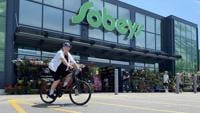NEW YORK (AP) — Wall Street rallied to claw back most of the losses from its slow start to the year. The S&P 500 rose 1.4% Monday to pull within 1% of its all-time high. The Nasdaq composite rose 2.2%, and the Dow added 0.6%. Boeing dragged on the Dow after one of its jets suffered an inflight blowout. Oil-and-gas companies were also weak after crude prices tumbled on worries about weaker demand. But gains for Big Tech stocks and much of the rest of the market overshadowed those losses. They rose as Treasury yields eased.
THIS IS A BREAKING NEWS UPDATE. AP’s earlier story follows below.
NEW YORK (AP) — Wall Street is rallying Monday to claw back most of the losses from its slow start to the year.
The S&P 500 was 1.2% higher in late trading to pull within 1% of its all-time high set two years ago. It's a return of momentum for Wall Street's main measure of health, which is coming off its first losing week in the last 10.
The Nasdaq composite was 2% higher, as of 3 p.m. Eastern time, and the Dow Jones Industrial Average was lagging the market with a more modest gain of 146 points, or 0.4%.
Boeing was dragging on the Dow in its first trading after over Oregon. It fell 6.5%. Spirit AeroSystems, which builds fuselages and other parts for Boeing, lost 6%.
Stocks of oil-and-gas companies were also heavy weights after Saudi Arabia gave indications of potentially weak demand for crude. Exxon Mobil fell 2.1%, and Halliburton lost 2.5% as a barrel of U.S. crude tumbled $3.04 to $70.77.
But much of the rest of Wall Street was rising as easing Treasury yields relaxed the pressure on the stock market.
Big Tech stocks led the way. They were the main reason for Wall Street's big gains last year, when excitement around artificial-intelligence technology helped a handful of just seven account for the majority of the S&P 500's returns. But they stumbled last week as markets broadly regressed.
Nvidia rose 5.2% after announcing new products and describing how it’s helping to insert AI in everything from autonomous robots to the discovery of new drugs. Apple, meanwhile, rose 2.2% to bounce back from its worst week since September. They were the strongest forces lifting the S&P 500, along with Microsoft and Amazon.
Commercial Metals also jumped 7.8% after reporting stronger profit for the latest quarter than analysts expected. It said construction activity is healthy in North America, driving demand for steel and helping to offset weaker conditions in Europe.
More earnings results will be arriving at the end of the week. Delta Air Lines, JPMorgan Chase and UnitedHealth Group will be among the companies on Friday kicking off the S&P 500’s reporting season for the final three months of 2023.
The highlight of the week may be Thursday’s release of the latest inflation data for U.S. consumers. A cooldown there has ignited hope on Wall Street that will soon see enough improvement to not only halt its hikes to interest rates but begin cutting them.
The Fed has already hiked its main interest rate to the highest level since 2001, which grinds down on the economy and hurts prices for investments, in hopes of conquering high inflation. The Fed said last month it’s seen improvement, and Wall Street’s expectation is for it start cutting rates as soon as March.
Treasury yields have already sunk in the bond market on such expectations, and they edged lower Monday. The yield on the 10-year Treasury sank to 4.01% from 4.05% late Friday. It was above 5% during October, at its highest point since 2007 and putting sharp downward pressure on the stock market.
The resulting rally for stocks carried the S&P 500 near its all-time high. But that strength also caused some on Wall Street to say at least a pause for stocks is likely in the near term. The market looks “extremely expensive,” according to Lisa Shalett, chief investment officer at Morgan Stanley Wealth Management.
Critics also warn that traders on Wall Street may be too optimistic about how deeply the Federal Reserve may cut rates this year. The Fed has indicated three cuts may arrive in 2024, but many traders are anticipating at least six. Such a high number may not be likely unless a recession arrives to force the Fed’s hand, critics say.
That’s why much focus is on corporate profits, where growth could help prop up stock prices.
Analysts expect companies in the S&P 500 to report growth of 1.3% in earnings per share for the fourth quarter of 2023 from a year earlier, according to FactSet. While that’s a relatively meager number, it would mark just a second straight quarter of growth.
Helen of Troy, the company behind such brands as Hydro Flask, Osprey and Drybar, rose 4.3% after reporting stronger profit for its latest fiscal quarter than analysts expected. Incoming CEO Noel Geoffroy said the company did better than it had expected despite “what continues to be a challenging macro consumer environment.”
Elsewhere on Wall Street, the fallout from waned. Alaska Air Group was down just 0.1% after falling sharply earlier in the day. United Airlines, which flies the same Boeing model and also had to cancel flights due to its grounding, opened lower and swung a few times before rising 3.3%.
In stock markets abroad, indexes were mixed. Hong Kong’s Hang Seng sank 1.9%, led by losses for property and technology shares, while stocks fell 1.4% in Shanghai.
Property shares tumbled after Zhongzhi Enterprise Group, a major lender to real estate developers, filed for bankruptcy in Beijing. China also against five American defense-related companies in response to U.S. arms sales to Taiwan and U.S sanctions on Chinese companies and individuals.
___
AP Writers Zimo Zhong and Matt Ott contributed.








































